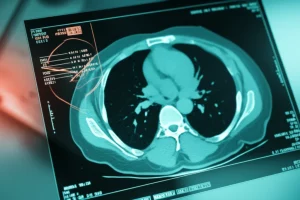When Kidneys Go Wild: Unpacking a Super Rare Case of ADPKD, GCK, and TBMN
Alright, let’s talk kidneys. Specifically, let’s talk about a truly fascinating, head-scratching case that popped up recently. You know, the kind that makes doctors lean back in their chairs and say, “Huh, well, isn’t *that* something?” We’re diving into the world of kidney diseases, but not the usual suspects. We’re looking at a situation where several rare conditions decided to have a little party in one person’s kidneys, creating a diagnostic puzzle.
Normally, when we talk about genetic kidney diseases, Autosomal Dominant Polycystic Kidney Disease (ADPKD) is the big one. It’s the most common inherited kidney disorder out there, affecting about 1 in 1000 people. It’s usually pretty straightforward: kidneys get big, filled with lots of cysts, and often lead to kidney failure later in life. It’s caused by mutations, usually in the PKD1 or PKD2 genes. Easy peasy, right? Well, not always.
Then there’s Glomerulocystic Kidney (GCK). This one’s much less common, especially in adults. Instead of cysts forming mainly from the kidney tubules (like in typical ADPKD), GCK involves cysts forming right within the tiny filtering units of the kidney, the glomeruli. Think of it as Bowman’s capsule (the little cup surrounding the filtering tuft) getting way too big, like a balloon inflating.
And just to make things extra interesting, there’s Thin Basement Membrane Nephropathy (TBMN). This is often linked to blood in the urine (hematuria) and happens when the filtering membrane in the glomeruli (the glomerular basement membrane, or GBM) is thinner than it should be. It’s often pretty benign, but it can sometimes hang out with other kidney issues.
Now, imagine all three of these showing up in one person, in a way that’s totally unexpected. That’s the case we’re exploring. An atypical presentation of ADPKD showing up as GCK, *plus* having TBMN along for the ride. It’s like a medical unicorn.
The Patient’s Story: Not Your Typical ADPKD
So, we have this 40-year-old guy. He comes in because he’s noticing foamy urine, which can be a sign of protein leaking into the urine. He also has microscopic blood in his urine (microhematuria) and his kidneys aren’t working quite as well as they should be (mild renal insufficiency). Okay, standard kidney workup time.
What’s immediately unusual? He has absolutely no family history of kidney disease. None. For ADPKD, which is *dominant* (meaning you usually inherit it from a parent), this is a bit of a curveball. His physical exam is mostly normal, except for some mild abdominal tenderness. No signs of other genetic syndromes, no hearing loss, nothing else obvious.
Lab tests confirm the proteinuria and microhematuria. His kidney function is slightly reduced, but not drastically so. Standard stuff checks out – no diabetes, no autoimmune issues showing up in the blood tests.
Initial Imaging: A Few Cysts, But Not the Full Picture
Next up, imaging. An ultrasound shows his kidneys are slightly enlarged, and the outer part (the cortex) looks a bit brighter than usual. They see a couple of small cysts on each kidney. A CT scan confirms 2 or 3 small cortical cysts, the biggest one being about 28×29 mm. But here’s the thing: based on standard criteria used to diagnose ADPKD with imaging (like the Ravine criteria, which look for a certain number of cysts based on age and family history), this *doesn’t* scream ADPKD, especially without that family history.
No blockages (hydronephrosis) are seen, and no cysts show up in his liver or pancreas, which are common spots for cysts in typical ADPKD. So, imaging alone isn’t giving us a clear ADPKD diagnosis.

The Biopsy: Unmasking the Unexpected
When the picture isn’t clear from symptoms and imaging, a kidney biopsy is often the next step. This is where things get really interesting. Under the microscope, they look at 27 glomeruli. Four are already scarred, which isn’t great, but the big surprise is that a whopping 33.3% (9 out of 27) of the glomeruli have those massively dilated Bowman’s spaces – the hallmark of GCK! The diameters are huge, averaging around 785 micrometers.
The cells lining these glomerular cysts look like the normal cells from Bowman’s capsule (parietal epithelial cells), confirmed by special staining (positive for Claudin-1, negative for markers of tubular cells). This tells us these cysts are indeed coming from the glomeruli, not the tubules, which is key for GCK.
They also see some mild scarring in the tissue between the tubules (interstitial fibrosis) and a few inflammatory cells, but nothing major there. The blood vessels look fine.
But wait, there’s more! They look at the tissue with a super-powerful microscope, a Transmission Electron Microscope (TEM). This is where they check out the tiny details, like the thickness of the glomerular basement membrane (GBM). And guess what? The GBM is thin. Really thin. The average thickness is measured at 221 ± 25 nm. The normal range for adult males is usually around 373 ± 42 nm. This thinness meets the criteria for TBMN.
Crucially, the TEM doesn’t show any splitting or lamellation of the GBM, which you’d typically see in something like Alport syndrome (another genetic kidney disease that involves thin GBM and can cause blood in the urine). No weird deposits are seen either. The structure of Bowman’s capsule itself looks normal, just dilated.

Genetic Testing: The Missing Piece
With this bizarre combination of GCK and TBMN, especially with the symptoms, the doctors start thinking about genetic causes. They run a next-generation sequencing test, which looks at a bunch of genes known to cause kidney problems. And bam! They find it. A pathogenic heterozygous deletion in exon 3 of the PKD1 gene. Remember PKD1? That’s the main gene for ADPKD!
Since there was no family history, they test the parents. Neither parent has the PKD1 mutation. This means the mutation in the patient is a de novo mutation – it happened spontaneously in him, not inherited. This explains the lack of family history, but confirms the genetic cause of ADPKD.
They also found a mutation in the NPHP1 gene, but it was a heterozygous missense mutation. Testing the father and son showed they also carried this NPHP1 variant, but the son didn’t have the PKD1 mutation. Since Nephronophthisis (caused by NPHP1) is usually recessive (requiring two bad copies of the gene), this single heterozygous mutation in NPHP1 is unlikely to be the cause of his kidney problems.
Importantly, the genetic testing *didn’t* find mutations in genes commonly associated with TBMN or Alport syndrome (like COL4A3, COL4A4, COL4A5) or other genes linked to hereditary GCK (like UMOD, TCF2, HNF1β).
Putting It All Together: A Rare Overlap
So, what do we have? An adult man with a confirmed PKD1 mutation (the cause of ADPKD), but his kidneys look like GCK on biopsy (glomerular cysts), and he also has TBMN (thin GBM). This is highly unusual.
Typical ADPKD presents with large, numerous cysts from tubules. GCK in ADPKD is usually seen in infants or children, not adults, and often involves cysts from both glomeruli and tubules. TBMN is usually just hematuria and often doesn’t cause significant proteinuria or kidney insufficiency, and it’s typically linked to different genes (COL4A3/4).
This case is a perfect storm of atypical presentations:
- ADPKD caused by a de novo PKD1 mutation (explaining the lack of family history).
- ADPKD presenting primarily as GCK in an adult (very rare).
- GCK coexisting with TBMN (also very rare, only one other case reported, and that one wasn’t linked to ADPKD genes).
The initial imaging didn’t meet standard ADPKD criteria because the cysts were small and few. It turns out MRI is better at picking up those smaller cysts (2-3mm vs 10mm for ultrasound), and after the genetic diagnosis, an MRI did show more cysts, confirming the polycystic nature, even if they weren’t the giant ones typical of later-stage ADPKD.
The biopsy was key, showing the GCK pattern and the TBMN. The genetic test provided the definitive answer about the underlying cause being ADPKD, despite the unusual presentation.

Why This Case Matters
This case is a fantastic reminder for doctors (and anyone interested in medical mysteries) that diseases don’t always read the textbook. ADPKD can show up in weird ways, and GCK, while rare, needs to be on the radar, even in adults. Just because someone doesn’t have a family history or the classic imaging findings doesn’t mean they don’t have a genetic kidney disease like ADPKD.
It highlights the crucial role of kidney biopsy and, increasingly, genetic testing in diagnosing complex or atypical kidney conditions. GCK isn’t just one thing; it can be part of various syndromes or stand alone. Figuring out *why* someone has GCK often requires looking beyond the microscope and into their genes.
So, while this specific combination of atypical ADPKD presenting as GCK superimposed with TBMN might be incredibly rare, the lessons learned are universal: keep an open mind, use all the diagnostic tools available, and remember that sometimes, the most important clues are hidden in plain sight… or in this case, in the glomeruli and the genes.
Source: Springer







